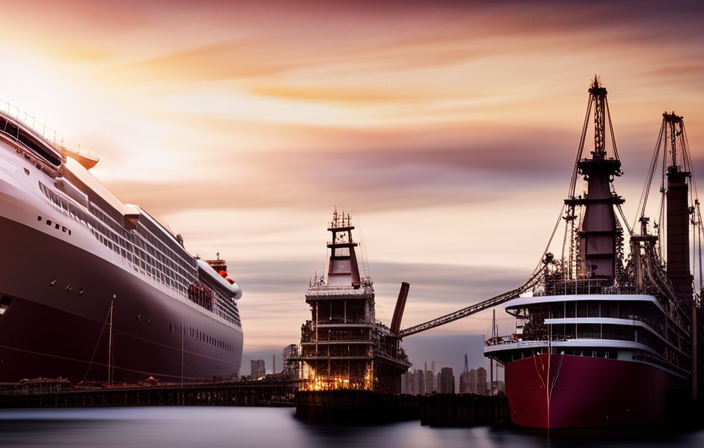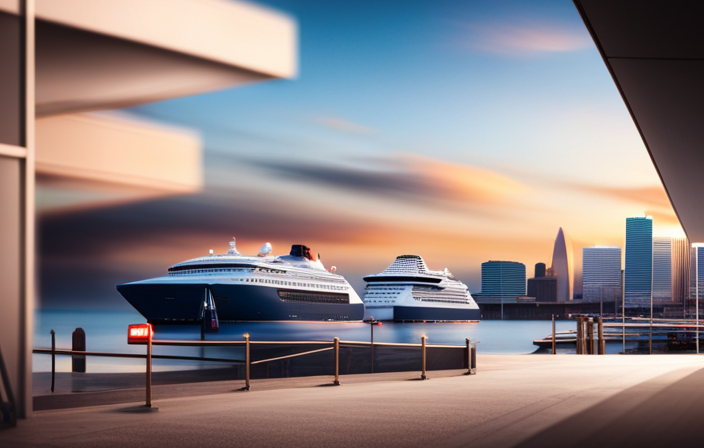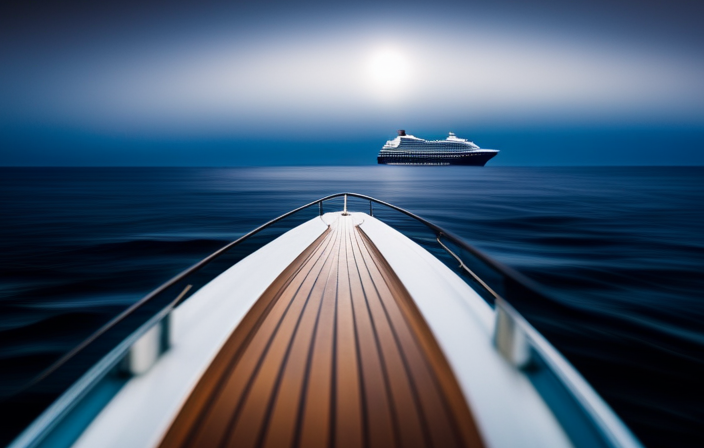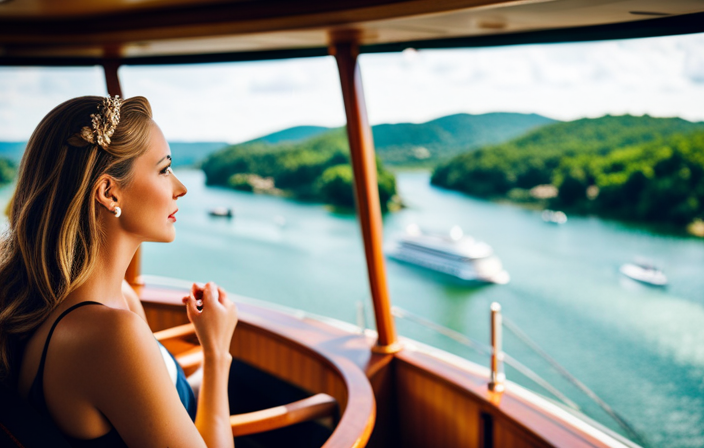Ever wonder about the time it takes to construct a cruise ship? This question ignites curiosity and wonder. As someone with extensive experience in shipbuilding, I can attest that building a cruise ship is a detailed and sophisticated process. It involves meticulous planning, expert workers, and cutting-edge technology. Each stage, from design to launch, is vital in creating these extraordinary vessels. Dive into the exciting world of cruise ship construction to uncover the secrets behind these magnificent creations.
First, there’s the procurement of materials and components, followed by the construction of the hull where all the machinery and systems will be installed. Then comes the interior design and furnishing, adding elegance and comfort to every corner of the ship. Finally, there are certification processes and safety inspections to ensure that everything meets rigorous standards.
Join me on this fascinating journey as we dive deep into each stage of building a cruise ship. Together, we’ll uncover the time it takes to create these floating wonders of modern engineering.
Key Takeaways
- Design and Conceptualization: The process of designing a cruise ship involves addressing challenges related to safety, functionality, and aesthetic appeal. It also involves accommodating passengers and offering luxurious amenities, selecting materials for marine conditions, and balancing innovative design concepts with practicality.
- Procuring Materials and Components: Sourcing reliable manufacturers for high-quality materials and evaluating suppliers is an important aspect of cruise ship construction. Establishing a manufacturing timeline and coordinating between suppliers and shipyard is crucial in procuring steel plates, pipes, electrical systems, and furnishings.
- Construction of the Hull: Ensuring structural integrity and weight balance is essential during the construction of the hull. Skilled workers assemble massive sections and weld them together, while precision and coordination are required for this process. The hull serves as the foundation for the installation of machinery and systems.
- Installation of Machinery and Systems: Equipping the hull with necessary machinery and systems is a complex process that requires cost and budgeting considerations. Project management techniques are employed to ensure a smooth timeline and successful integration of propulsion, electrical, communication, plumbing, HVAC, and fire safety systems. Several months are typically required for this phase of construction.
Design and Conceptualization
Designing and conceptualizing a cruise ship can be an exhilarating journey filled with endless possibilities. As the architect, I am faced with various design challenges that must be carefully addressed to ensure the safety, functionality, and aesthetic appeal of the vessel.
The architectural vision for the cruise ship involves creating a space that not only accommodates thousands of passengers but also offers luxurious amenities and state-of-the-art facilities. From determining the optimal layout to selecting materials that can withstand harsh marine conditions, every decision plays a crucial role in bringing this grand vision to life.
However, amidst all these complexities, it is important to maintain a balance between innovative design concepts and practicality. With the design process complete, attention now turns towards procuring materials and components necessary for construction without compromising on quality or efficiency.
Procuring Materials and Components
When you’re ready to start, you’ll be amazed at the intricate process of sourcing and gathering all the necessary materials and components for your magnificent vessel.
Sourcing suppliers is a crucial step in ensuring that you obtain high-quality materials for the construction of your cruise ship. It involves identifying reliable manufacturers who can provide the specific components required for each section of the ship. This process requires meticulous research and evaluation to ensure that all suppliers meet stringent quality standards.
Once suppliers have been identified, a manufacturing timeline is established to coordinate the procurement of materials and components. This timeline takes into account lead times, production capacities, and shipping logistics to ensure a smooth flow of supplies during construction. Coordination between suppliers and the shipyard is vital throughout this phase to avoid delays or bottlenecks in production.
With all necessary materials secured, including steel plates, pipes, electrical systems, and furnishings, it’s time to move on to the next phase: construction of the hull.
Construction of the Hull
Once all the necessary materials and components have been procured, it’s time to commence the construction of the vessel’s hull. This crucial step in building a cruise ship involves various challenges due to the size and complexity of the structure. One of the primary challenges is ensuring structural integrity while maintaining an optimal weight balance. To address this, innovative hull designs are employed, such as double-hulled configurations and advanced steel alloys that offer enhanced strength and durability. These designs not only enhance safety but also improve fuel efficiency and reduce environmental impact. Construction begins by assembling massive sections called "blocks," which are then welded together to form the hull. This process requires meticulous precision and coordination among skilled workers. Once complete, the hull serves as the foundation for further installation of machinery and systems necessary for a fully functional cruise ship.
Transitioning into the subsequent section on ‘installation of machinery and systems,’ we move from constructing a strong foundation to equipping it with essential components vital for seamless operation.
Installation of Machinery and Systems
The next step in the process involves equipping the hull with various machinery and systems, turning it into a fully functional vessel that runs like a well-oiled machine.
This stage requires meticulous cost and budgeting to ensure that all necessary equipment can be acquired within the allocated funds. Advanced project management techniques are employed to create a timeline for the installation of each system, considering factors such as complexity and interdependencies.
The propulsion system, electrical distribution network, and communication systems are carefully integrated into the ship’s structure. Additionally, plumbing, HVAC, and fire safety systems are installed to meet stringent safety regulations.
This stage typically takes several months to complete due to the complexity of integrating multiple systems seamlessly.
Once this phase is finished, we transition into the subsequent section about ‘interior design and furnishing’, where attention shifts towards creating luxurious spaces for passengers’ comfort and enjoyment without compromising on safety or functionality.
Interior Design and Furnishing
To truly create an opulent masterpiece, you must focus on the interior design and furnishing of your vessel. The interior design challenges in building a cruise ship are vast and complex. Every inch of the ship needs to be carefully planned and executed to create a luxurious and inviting atmosphere for the passengers. From the grand atriums to the elegant cabins, attention to detail is paramount. When it comes to luxury furnishing trends, there is a constant demand for innovative designs that provide both comfort and style. Passengers expect nothing less than the best when they step onboard a cruise ship, so staying updated with the latest trends is essential.
| Column 1 | Column 2 | Column 3 |
|---|---|---|
| Elegance | Sophistication | Comfort |
| Exclusivity | Modernity | Functionality |
| Quality | Craftsmanship | Innovation |
As we move forward into testing and trials, we ensure that every aspect of our creation meets the highest standards before its maiden voyage.
Testing and Trials
Now, you can finally experience the thrill of putting your creation through rigorous testing and trials to ensure its flawless performance on its maiden voyage – because only then will you truly understand the saying, ‘The proof is in the pudding.’
The commissioning process marks a critical phase in building a cruise ship. It involves thoroughly testing all systems, from propulsion and navigation to safety and emergency procedures. Engineers meticulously inspect every component, leaving no room for error.
Sea trials are an integral part of this process, where the vessel is taken out to open waters for comprehensive performance evaluation. Speed tests determine the ship’s maximum velocity while stability assessments measure its ability to withstand harsh conditions. These trials provide valuable data that inform necessary adjustments before finalizing the ship’s design.
With each successful test passed, we move closer to completing this magnificent vessel, readying it for its grand debut on the open sea—a testament to our unwavering commitment to excellence in shipbuilding.
As we conclude these essential testing phases, we transition into perfecting every last detail and adding those final touches that will make this cruise ship an unparalleled marvel at sea.
SUBTOPIC: ‘Final Touches and Detailing’
Final Touches and Detailing
After the rigorous testing and trials, it’s time to move on to the final touches and detailing phase of building a cruise ship.
This crucial stage involves giving the vessel its finishing touches and ensuring every aspect meets the highest standards of aesthetics. Attention to detail is paramount during this phase as even the smallest imperfections can detract from the overall experience for passengers.
The cruise ship detailing team meticulously inspects every inch of the ship, focusing on areas such as cabin interiors, public spaces, and exterior surfaces. They ensure that everything is in perfect order – from polished handrails to flawlessly painted hulls.
Only when every element has been thoroughly checked and deemed flawless can we proceed to the next phase – certification and safety inspections. Regulatory bodies will assess our workmanship before granting approval for operation.
Certification and Safety Inspections
The final step before the cruise ship embarks on its maiden voyage involves a meticulous inspection by regulatory bodies to ensure the vessel’s certification and safety. This certification process is crucial to guarantee that the ship meets all necessary safety regulations and standards.
Here are three key aspects of this inspection:
-
Structural Integrity: The ship’s construction, including its hull, superstructure, and other essential components, is thoroughly examined to ensure it can withstand the harsh conditions of the sea.
-
Emergency Systems: All emergency equipment, such as lifeboats, fire suppression systems, and evacuation procedures, are assessed for their effectiveness and compliance with safety protocols.
-
Navigation Equipment: The ship’s navigation systems undergo rigorous testing to confirm their accuracy and reliability in guiding the vessel safely through various weather conditions.
Once these inspections are successfully completed and all necessary certifications obtained, the cruise ship is ready for delivery and launch into its exciting journey across oceans worldwide.
Delivery and Launch
Once all necessary certifications have been obtained, the cruise ship is set to be delivered and launched into its thrilling voyage, with an impressive 90% of the world’s population living within a two-hour drive of a cruise port.
Delivery logistics play a crucial role in ensuring the smooth transition from shipyard to destination. The coordination of transport vessels, such as tugboats and pilot boats, along with navigation through narrow waterways can be challenging.
Additionally, launch preparations involve final inspections and testing to guarantee optimal performance and safety. This includes conducting sea trials to assess maneuverability, stability, and propulsion systems. Once these preparations are complete, the ship is positioned for launch by flooding dry docks or using specially designed launching systems.
This seamless process ensures that the cruise ship embarks on its maiden voyage without delay or complications.
Transitioning into post-launch follow-up and maintenance involves meticulous attention to detail in order to address any potential issues discovered during initial operations without sacrificing passenger experience or safety standards.
Post-launch Follow-up and Maintenance
To ensure a smooth sailing experience, you’ll need to carefully attend to post-launch follow-up and maintenance tasks.
After the cruise ship is launched, it is crucial to focus on post-launch marketing efforts. This involves promoting the ship through various channels such as social media, advertising campaigns, and collaborations with travel agencies. By creating buzz and generating interest among potential passengers, we can maximize bookings and revenue.
In addition to marketing activities, ongoing maintenance plays a vital role in ensuring the ship’s longevity and functionality. Regular inspections must be conducted to identify any potential issues or wear-and-tear that may have occurred during the construction or launch process. This includes examining all mechanical systems, electrical components, safety features, and interior amenities.
Furthermore, continuous cleaning and upkeep are necessary to provide a pleasant environment for passengers throughout their journey. From polishing floors and maintaining cabin facilities to servicing dining areas and recreational spaces, attention to detail is key.
Overall, a well-executed post-launch strategy combined with diligent maintenance practices will contribute greatly to the success of your cruise ship venture.
Frequently Asked Questions
What are the key factors that determine the duration of the design and conceptualization phase for a cruise ship?
The duration of the design and conceptualization phase for a cruise ship is influenced by factors such as cost and budgeting, along with the role of technology and innovation in the construction process.
How do cruise ship manufacturers ensure the quality and reliability of the materials and components they procure?
In the procurement process, cruise ship manufacturers ensure quality and reliability of materials and components through rigorous quality control measures. This includes conducting thorough inspections, testing for durability and performance, and partnering with reputable suppliers to guarantee high standards are met.
What are the main challenges typically faced during the construction of a cruise ship’s hull, and how are they overcome?
During construction, challenges arise such as welding difficulties, ensuring structural integrity, and managing the weight distribution. These obstacles are overcome through meticulous planning, advanced engineering techniques, quality control measures, and collaboration between different teams.
How is the installation of machinery and systems coordinated to ensure smooth operations on a cruise ship?
To ensure smooth operations on a cruise ship, installation coordination is crucial. This involves carefully planning and organizing the installation of machinery and systems, ensuring proper alignment, integration, and functionality for efficient and reliable performance.
What factors are considered when choosing the interior design and furnishings for a cruise ship, and how are they implemented to create a luxurious experience for passengers?
When considering interior design for a cruise ship, I analyze current trends to create an atmosphere of opulence and elegance. I meticulously select furnishings to maximize passenger comfort, ensuring a luxurious experience onboard.
Conclusion
In conclusion, building a cruise ship is a breeze!
First, meticulous design and conceptualization are key.
Next, the procurement of top-notch materials ensures quality construction.
Then, the construction of a sturdy hull takes place.
After that, the installation of cutting-edge machinery and systems occurs.
Additionally, exquisite interior design and furnishing add the perfect touch.
And let’s not forget about those necessary safety inspections and certifications – just to keep things interesting!
Finally, after all that hard work, we deliver and launch these magnificent vessels into the open sea.
It’s truly a labor of love that guarantees an unforgettable experience for all aboard.










